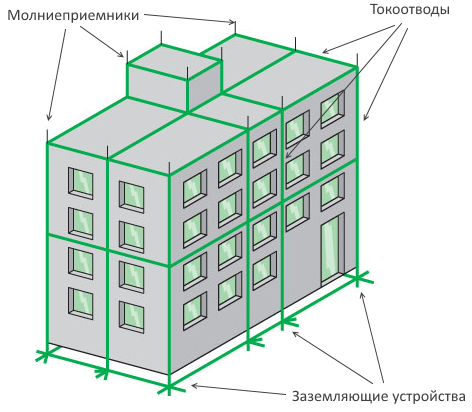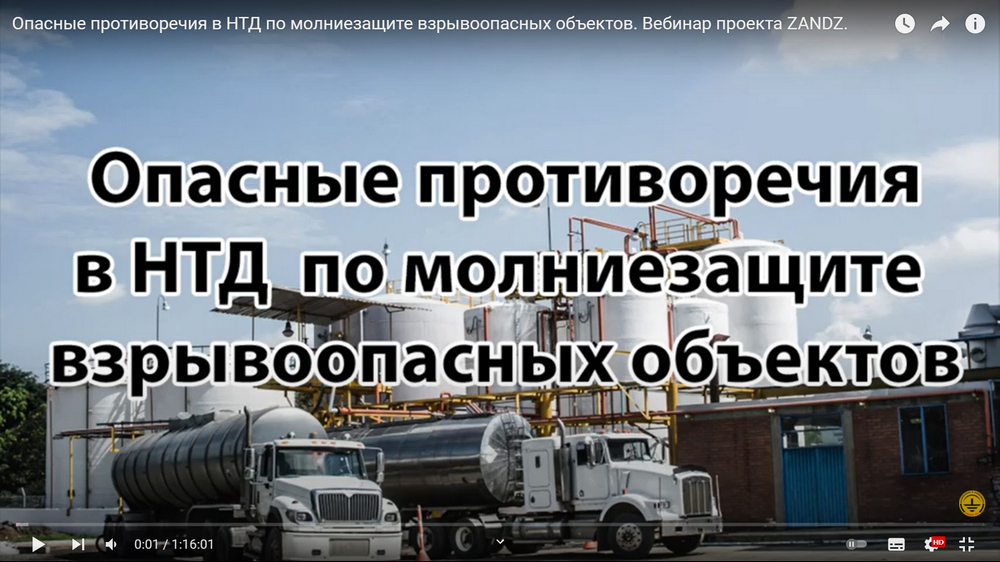Cost effectiveness is an important but not the decisive factor in the external lightning protection. Saving on quality and quantity of various components, either lightning rods or down conductors, may reduce the efficiency of the whole lightning protection system to zero, while losses after a thunderstorm and repair costs can be much higher than the saved funds. How does it relate to down conductors? Let's settle this issue!
External lightning protection consists of several elements:
- lightning rod, an element receiving the blow of lightning;
- down conductor, an element conducting the lightning current into the ground;
- grounding connection , the final element of the external lightning protection system reducing the resistance to distribute the lightning current in the ground.

Lightning rods
Down conductors
Grounding devices
You know, of course, that the number of lightning rods directly affects the protection quality. 'Wrong' allocation of lightning rods or in their insufficient number can result in lightning strike an object, which should be avoided in all possible ways. Everyone understands this. Unfortunately, not everyone takes into account the importance of other elements, such as down conductors. Pretty often people ignore the rules of lightning protection arrangement, when the conductor is installed in the wrong way or not installed at all (for example, in order not to spoil the appearance of the object). Such errors are common not only among inexperienced house owners; they are also typical for large buildings: shopping centers, office buildings and so on.
Requirements to down conductors:
-
1. Down conductor material
Requirements to materials are stated in "Instructions for lightning protection arrangement of buildings, structures and industrial facilities CO 153-34.21.122-2003":
|
Protection level |
Material |
Section, mm2 |
|
I-IV |
Steel |
50 |
|
I-IV |
Aluminum |
25 |
|
I-IV |
Copper |
16 |
-
2. The number of down conductors and distance between them
According to CO 153-34.21.122-2003, to reduce the likelihood of dangerous sparking down conductors should be allocated in such a way that between the hitting point and the ground current spreads along several parallel paths, the length of which should be as small as possible.
Rules of allocation of down conductors isolated from the protected object:
- For lightning rods mounted on separate supports (or one support), each support must be equipped with at least one down conductor.
- The protective earth wire requires at least one down conductor for each cable end.
- For net-shaped lightning rods positioned above the object to be protected each support requires at least one down conductor. The total number of down conductors should be at least two.
Down conductors not isolated from lightning protection devices must correspond to the following requirements: they must be positioned along the perimeter of the building, while the average distance between them most not be less than the values given shown in the table below.
|
Protection level |
Average distance, m |
|
I |
10 |
|
II |
15 |
|
III |
20 |
|
IV |
25 |
Close to the earth surface and every 20 m along the height of the building the down conductors are connected by means of horizontal connecting elements, such as strips or wire.
3. Allocation of down conductors
Arrangement of down conductors should follow the principal rule: the distance to the ground should be as short as possible, bending or geometric shapes of any kind are not allowed. Down conductors should be positioned along the perimeter of the protected object close to corners of buildings. Down conductors not isolated from the protected object should be arranged as follows:
- if the wall is made of non-combustible material, the down conductors can be mounted on the wall surface or placed inside the wall;
- if the wall is made of combustible material, the down conductors can be mounted directly on the wall surface, so that the temperature rise would not cause any danger to the wall material when the lightning current goes through;
- if the wall is made of combustible material and the increasing temperature of the down conductors is dangerous for this material, the down conductors should be placed in such a way that the distance between them and the object to be protected is always more than 0.1 m. Metal brackets for fixing of the down conductors can be in contact with the wall.
It is recommended to position down conductors as far as possible from doors and windows (using of drainage pipes is not recommended).
-
4. Use of natural elements as down conductors
According to paragraph 3.2.2.5 CO 153-34.21.122-2003, the following structural elements of buildings can be used as down conductors:
- metal structures, if their dimensions are not smaller than those required for specially designed down conductors
- metal frame of buildings or structures;
- Interconnected iron mountings of buildings or structures;
- face elements, profiled elements and supporting metal structures of the face, provided that their dimensions correspond to the instructions for the down conductors, and their thickness is not less than 0.5 mm.
You will find the full list of requirements to lightning rods in a separate page.
Related Articles:


.jpg)
.jpg)

